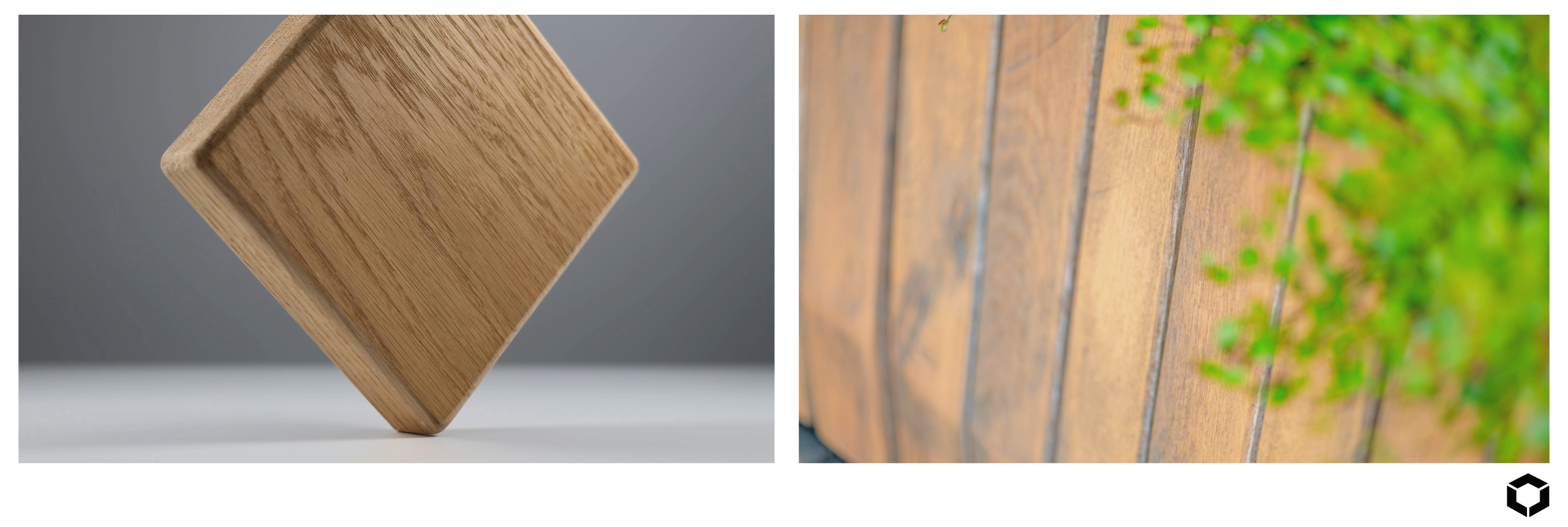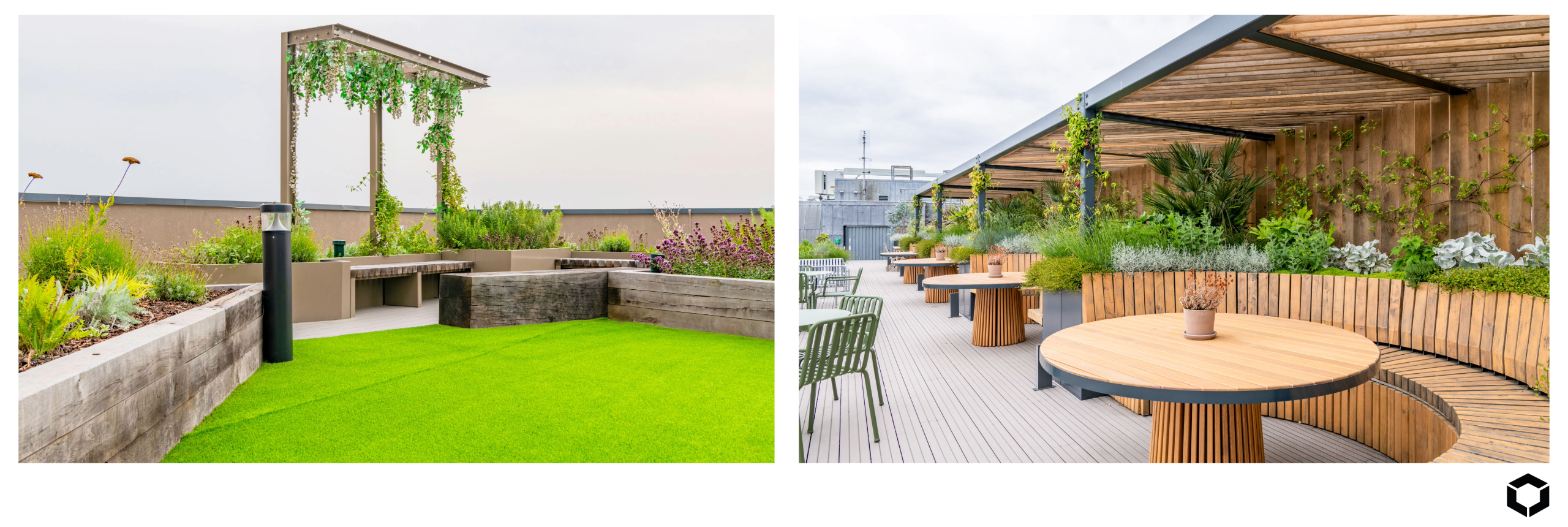
As a landscape architect, selecting the right materials can make or break your design. English Oak (Quercus robur), one of the most iconic native species in the UK, has long been a favoured timber for its beauty, strength, and sustainability. But is it the right choice for your next landscape project?
In this blog, we’ll explore why English Oak is a standout material in landscape design, its many benefits, some of the challenges you should be aware of, and how to make the most of this extraordinary timber.
In this article:
The first thing that strikes you about English Oak is its undeniable beauty. With its distinctive golden-brown hues that evolve into rich silvery greys over time, English Oak offers a warmth and organic texture that is both elegant and rustic. The wood’s natural grain, with occasional knots and patterns, gives it a unique character, making each piece a one-of-a-kind element in your landscape design.
English Oak works in a range of settings, from the more formal and structured to the relaxed and organic. When used for seating or cladding, its classic appeal complements both contemporary and traditional designs, offering versatility without compromising on style. It pairs effortlessly with other materials like steel, stone, or even contemporary concrete while allowing surrounding plants or garden features to take centre stage.

Perhaps one of the most attractive qualities of English Oak is how it ages gracefully. Unlike synthetic materials that degrade with time, oak becomes more striking as it weathers, gaining a patina that enriches its visual appeal. This makes it a perfect choice for long-lasting installations in public parks, garden features, and commercial spaces, where the design will evolve over time, maintaining its beauty for generations.
English Oak is more than just a beautiful material; it’s incredibly strong and durable, making it a top choice for a wide range of landscape applications.
1. Durability:
Oak is known for its resistance to decay and weathering. Classified as a Class 2 timber (moderately durable) in terms of decay resistance, English Oak has been used in construction for centuries, from shipbuilding to structural beams, proving its resilience. Its natural durability makes it ideal for outdoor furniture, planters, decking, and cladding, ensuring your design will stand the test of time.
2. Strength:
English Oak is a dense and robust wood, capable of withstanding significant weight and pressure. This makes it an excellent choice for structural applications like seating or raised planting beds. Unlike softer woods, oak doesn’t warp easily and can bear heavy loads without losing its integrity. It’s often the go-to material for large-scale urban installations, such as park benches or statement outdoor sculptures, because of its long-lasting strength.
3. Sustainability:
When responsibly sourced, English Oak is a highly sustainable choice. The wood is readily available in the UK, which reduces transportation emissions compared to imported timbers. Additionally, oak is often sourced from FSC- or PEFC-certified forests, ensuring that it is harvested from well-managed woodlands that promote biodiversity and forest regeneration.
Another sustainability benefit is the material’s longevity. The more durable the timber, the less frequently it needs to be replaced, reducing waste and the overall environmental impact of your project. And, as oak is biodegradable and a natural carbon sink, it contributes positively to the environment long after installation.

Despite its many benefits, English Oak does come with some considerations that landscape architects should be mindful of. With a little care and attention to detail, these challenges can easily be addressed.
1. Tannins:
English Oak contains high levels of tannins, which are naturally occurring compounds that can leach out of the wood when exposed to moisture. This can result in the staining of adjacent surfaces, such as concrete, stone, or other light-coloured materials.
How to Mitigate: To avoid staining, use a tannin-blocking sealant to protect adjacent surfaces. Additionally, consider designing the oak elements to be elevated slightly from the ground, which helps prevent direct water contact and reduces tannin leakage.
2. Movement and Cracking:
Like all natural timbers, oak is subject to movement as it expands and contracts with changes in temperature and humidity. Over time, this can cause the wood to split or crack, particularly in applications where moisture levels fluctuate.
How to Mitigate: Use air-dried or seasoned oak for outdoor applications to ensure that it’s already stabilized before installation. Allow for natural movement in your designs by using appropriate joinery techniques that provide space for expansion and contraction.
3. Ground Contact:
While English Oak is naturally durable, prolonged exposure to soil or standing water can lead to decay.
How to Mitigate: Elevate your oak elements off the ground by using bases or feet, ensuring proper drainage and air circulation to avoid moisture build-up. This is particularly important for seating and planters placed in damp conditions.
Like any natural material, English Oak in Landscape Design benefits from regular maintenance to ensure its longevity and aesthetic appeal.
1. Cleaning:
Regularly clean oak surfaces with a soft brush or cloth to remove dirt and debris. Avoid harsh chemicals, as these can damage the natural finish of the wood.
2. Oiling and Sealing:
To protect its surface and maintain its rich, warm colour, apply natural oils such as linseed or tung oil. These oils nourish the wood, preventing cracking and preserving its appearance. If Oak has been treated, a maintenance program will have to be introduced to maintain its effect.
3. Sanding and Refinishing:
Over time, oak surfaces may show signs of wear. Light sanding followed by refinishing can restore the wood’s smooth texture and rich colour. Be sure to sand in the direction of the grain to avoid damage.
English Oak offers an unparalleled combination of beauty, durability, and sustainability, making it an excellent choice for a wide range of landscape applications. Whether used for seating, planters, or cladding, this iconic timber enhances the aesthetic and functional quality of any design.
By understanding its strengths and potential challenges—and taking the necessary steps to mitigate risks—you can create outdoor spaces that stand the test of time, both in terms of aesthetics and structural integrity.
With proper care, English Oak in landscape design can be an integral part of the space, offering both natural beauty and a sustainable solution that will resonate with visitors for years to come.
Back to the Knowledge Base